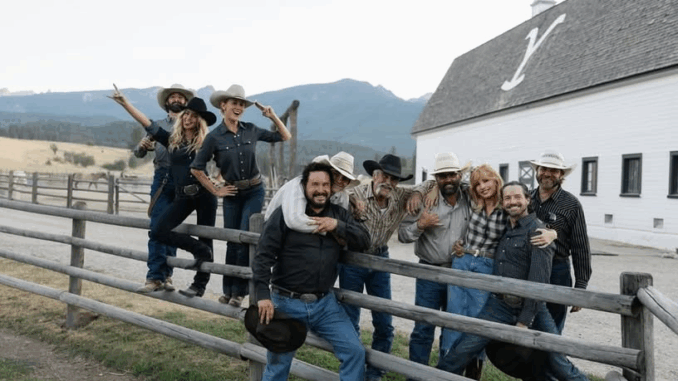
The “Yellowstone” TV Show Is Over, but Not the Damage It’s Done to the West
Why Yellowstone’s End Isn’t the End of Its Real-World Fallout
At first glance, Yellowstone seems like just epic entertainment—cowboys, ranch drama, high-stakes family conflict, and cinematic visuals. But beneath the flashy surface, it’s shaped perceptions, stereotypes, and expectations of the real American West. Now that the show is over, it’s time we ask: what’s the impact—and is it negative?
Shaping a Western Myth—and Its Consequences
Cowboys, Firearms, and Conflict
The show popularized the “cowboy as action hero” image: endless shootouts, lash-ups with land developers, and glorified vigilantism. This narrative fuels unrealistic ideas about rural America—that self-defense is always gun-based and violence is a first resort.
Ranch Drama as All-American Narrative
Yellowstone framed ranch life through the lens of wealth, power, and family legacy. Real Western ranchers, especially smaller family operations, don’t live like this. It’s privilege laid over tradition, not reality.
Tourism and the “Yellowstone Mirage”
Booming Tourism in Rural Areas
Film-driven traffic surged to Montana-set locations. Local ranches reported a sharp climb in visitors, many expecting the Dutton mansion or cattle drives. But unlike fantasy, real ranch life doesn’t include guided tours or staged drama.
Local Overload and Environmental Stress
Sudden tourist influx strains water, roads, and wildlife. Ranchers report increased traffic, litter, and trespassing. Nature didn’t come with a “set,” yet it’s forced to absorb the mythic influx.
Amplifying Misconceptions About Land and Law
Gun Culture and Cowboy Justice
Yellowstone glorified firearms—and without consequences. Casual gun use in domestic drama can reinforce a “shoot first, ask later” attitude that doesn’t reflect real rural law enforcement or legal structures.
Land Rights Fantasies vs. Legal Realities
The show champions private property versus big government. In real life, Western ranching depends on complex public land leases, environmental controls, and wild conservation. The oversimplified land war narrative romanticizes a fight that rarely exists as depicted.
Impact on Real Ranching and Rural Communities
Volatile Romanticization Hurts Small Ranchers
Young viewers inspired to buy ranches forget: real ranching involves financial risk, drought, unpredictable markets, and emotional toll—not wealth and control.
Pricing and Landscape Changes
As tourism and speculation infiltrate, rural property values spike. Locals can’t afford the land anymore. The shortage exacerbates population imbalance, school closures, and social erosion.
Media Representation vs. Authenticity
One-Dimensional Native and Latino Characters
Yellowstone includes Native and Latino faces, but rarely explores their real challenges in the region. It defaults to archetypes—the job, the help, the villain—ignoring the layered histories of marginalization, treaty rights, and land stewardship.
Environmental Oversights in Screenwriting
The show romanticizes open land and livestock, but shows little of climate uncertainty. There’s little mention of drought cycles, wildfire risk, or wildlife conflicts that define real ranch life.
Why the Damage Matters
Policy Implications and Cultural Perception
Shows affect how people vote, support public policy, or tolerate change. A romanticized, hostile view of regulation can impact water bills, environmental protection, and Indigenous rights advocacy.
Tourism as Double–Edged Sword
It can be economic salvation—but also erodes rural identity, pollutes landscapes, and fosters division between fans and locals who see their home reduced to a tourist backdrop.
Unpacking the Bigger Picture
It’s About Power, Not Pastoral Life
Yellowstone isn’t pastoral—it’s about power. The show frames its rural characters as feudal rulers, not working people. That breeds resentment toward government and empathy for the ultra-rich.
What’s Real Behind the Scenes?
Real cowboys drive tractors, not guns. Grasslands require days of fence repair, not political scheming. Wildfires demand understanding weather and ecosystems, not cowboy heroics.
How the Damage Can Be Mitigated After the Finale
Local Tourism Education Programs
Ranches can offer guided tours with sobering facts: the real costs of ranching, tourism impact, and maintenance challenges.
Media Literacy Advocacy
Fans should be encouraged to separate the story from reality. Farming classes, rural outreach, or documentary promos can keep perceptions grounded.
TV’s Responsibility When Mythologizing Landscapes
Content creators can include context: an occasional moment acknowledging public land dependence, environmental fragility, or legal nuance wouldn’t harm drama—it could enrich it.
Positive Lessons We Can Take
Drawing Attention to Rural Struggles
If we acknowledge misdirection, we can broaden the conversation. Drought, grid failure, mental health—Western life has real challenges worth exploring.
Opportunities for Authentic Storytelling
Rural voices need platforms. Original stories from real Native, Latino, and small-ranch families would balance the Dutton cascade.
Conclusion
Yellowstone painted the West in bold strokes, but it skipped the grit, nuance, and delicate balance real ranchers and rural communities face. As the series closes, it’s time to see the toll: increased tourism pressure, skewed stereotypes, and cultural distortion.
We can’t un-see what’s been seen—but by amplifying authentic voices, promoting grounded stories, and fostering media literacy, we can begin to repair the damage. The West deserves more than a TV lens—it deserves respect for what it truly is. That’s the legacy worth fighting for.
5 Unique FAQs
1. Did Yellowstone’s filming affect local economies negatively?
Tourist surges brought income, but also environmental strain—litter, road wear, and wildlife disruption have followed.
2. Are firearms realistically portrayed on-screen?
No. The show often normalizes gun use without legal or emotional accountability—a distortion that feeds certain rural stereotypes.
3. How does land ownership on the show compare to reality?
Real Western ranchers operate under public land regulations and conservation laws, not isolated mega-ranches fighting abstract “government” threats.
4. What do rural residents actually think of Yellowstone?
Many feel annoyed by trespassing tourists, land devaluation, and simplified portrayals of rural life and its challenges.
5. How can viewers help change the narrative?
Support authentic rural storytelling, documentary work, and nonprofits that share real Western experiences. Ask for nuance in dialogue—but don’t paint the West with one broad brushstroke.
